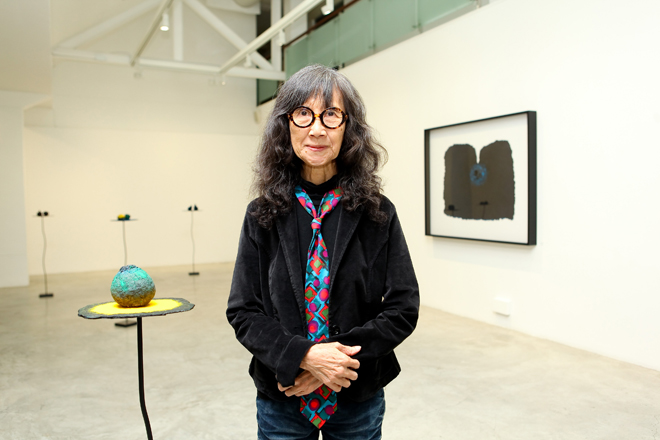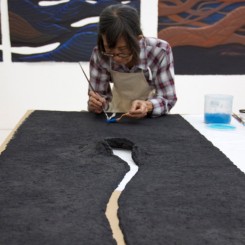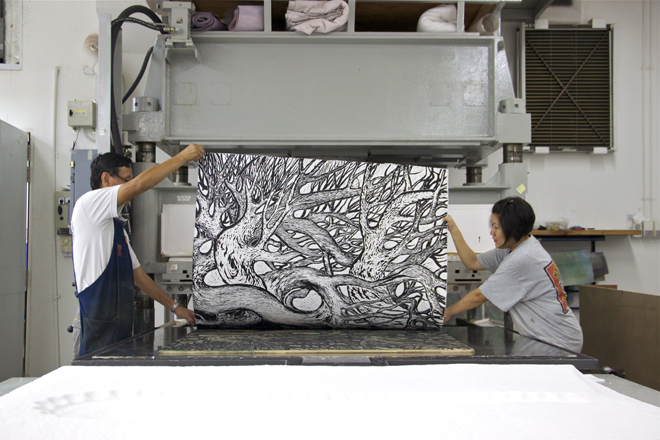Han Sai Por is a Singaporean artist born in 1943. Having studied abroad, she returned to Singapore in 1983, and has since become an internationally-acclaimed artist—particularly for her stone sculptures based on natural forms. Her work has been produced, shown and collected widely in Asia and the West. The culmination of a recent residency at the Singapore Tyler Print Institute is an extensive and impressive solo exhibition entitled “Moving Forest.” With numerous freestanding sculptures, mixed-media drawings and deeply-textured works in papier mache and cast paper, the show testifies to Han’s manual sensitivity and strength of purpose. Away from the noise of the fair, Iona Whittaker met Han to talk about her work, career and perspective on the art scene in her home country.
Iona Whittaker: How did it all begin for you? You are from Singapore originally.
Han Sai Por: I am 70 now; over this time, I have seen the changing landscape in Singapore. When I was young, Singapore was still covered in lots of forest and trees. Now, because this very intensive use of land has developed, our forest and trees have almost gone. I did some outdoor sculpture here and there in China—Beijing also has some works of mine. I’ve also taken part in some exhibitions in China, the US and UK and Japan, and also worked there.
My work is about nature and the environment. When I was small, we were very poor; we lived during the Japanese war. We didn’t have toys; we only played with nature and with plants and sea shells by the beach. This has influenced my concepts in sculpture.
IW: And you also studied in the UK, early on.
HSP: Yes, I was there for four and a half years. East Ham College and Wolverhampton College. Anish Kapoor was one of my lecturers—that was a long time ago; now he’s really famous.
IW: But at that time, in terms of the community of artists—was there one that you were part of?
HSP: No. I belong to the second generation. More people are doing painting than sculpture—it’s a very small group.

Han Sai Por at the exhibition “Moving Forest” at the Singapore Tyler Print Institute
韩少芙,《移动森林》个展,新加坡泰勒版画研究院
IW: Was sculpture something that you were aware of as you were growing up, as a form of art? Or, as you realised you wanted to be an artist, did you see sculpture and think “This is what I would like to do.”
HSP: Actually, it was not that way; I am from a village, and woodcuts come from that village. Since I was small I have always been a very physical person, doing outdoor things. I liked hands-on jobs—all the materials. From the beginning I drew, and learnt the basic techniques of drawing and painting. When I went to Wolverhampton, I had never thought about being a sculptor. In my first year, I did painting and drawing, and after that we had to choose a major in either painting or sculpture. My lecturer gave me advice, saying I was very good in three-dimensional work. He advised me to do the sculpture course.
IW: You must have been one of very few artists who were travelling so far to study, at that time.
HSP: Yes, because one needs financial support.
IW: If it’s not a rude question, how did you raise the money?
HSP: I was teaching before I went to study—for more than ten years at a school here, though not an art school. I trained as a teacher, and taught four different levels from primary school to college level. So, I actually have a lot of experience in education. I saved some money, and I also got a loan from the Ministry of Education.
IW: Was that loan specifically for artists? How did it work?
HSP: It was because in the past, our governor really understood the importance of art and why we need art. Art is important for real life—and also can make money, that’s a government thing! (Laughs). You see outside how it’s happened. And then a few art colleges and art schools were set up.
IW: How does that feel in terms of your career and communication with people?
HSP: The whole world is changing, and very fast. And with technology comes art—there’s art everywhere! (Laughing). When you went to Art Stage, did you feel confused? There are so many booths.
IW: I know; it is a lot to take in.
HSP: One result is that the work becomes more and more plastic. Now, I see more and more conceptual art, and less using materials—actual, finished work. And by that I mean work finished by the artist themselves. You need the time to spend on it.
IW: Do you follow young artists closely here, and work with them?
HSP: Yes. Actually, we have a Sculpture Society which I founded. We are a group of about 50 members. We work together for different activities—all my friends are younger than me!
IW: Are there things you feel—as a more mature artist here—that you want to care of for Singapore?
HSP: Yes, because a lot of my work is concerned with environmental issues. The things we have lost will never come back again. A lot of my activities now are about what I’m aware of now. Singapore is facing a concrete wall, and deforestation and loss of the rainforest is an issue in South-East Asia. I think this inspires me. My show “Black Forest”, for example, was an installation using burnt wood at the NAFA (Nanyang Academy of Fine Arts) gallery.
IW: I feel that perhaps it could happen that the community of artists in Singapore could become quite split up, for example between the emerging and more mature artists—though perhaps this is inevitable anywhere.
HSP: Yes, yes. You need to be active. People will see your work; if they say you are traditional and out of time, they will forget you. Now, people are interested in young people and fresh, new ideas.
IW: But also un-formed ideas!
HSP: Yes, I know! It’s about the depth of the concept, not just the surface and whether it’s new and fresh—what is the content of the work?




